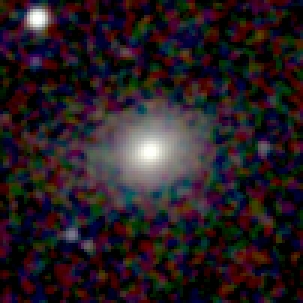http://cseligman.com/text/atlas/ngc78.htm wrote:
NGC 1 (= PGC 564),
1860 RA 00 00 04
Discovered (Sep 30, 1861) by Heinrich d'Arrest
A 13th-magnitude spiral galaxy (type SA(s)b) in Pegasus (RA 00 07 15.9, Dec +27 42 32)
Per Dreyer, NGC 1 (= d'Arrest,
1860 RA 00 00 04, NPD 63 04.3) is "faint, small, round, lying between 11th and 14th magnitude stars". The position precesses to RA 00 07 15.8, Dec +27 42 28, within 0.1 arcmin of the center of the galaxy, and there are appropriate stars to the northeast and southwest, so the identification is certain. Based on a recessional velocity of 4550 km/sec, NGC 1 is about 210 million light years away, in good agreement with redshift-independent distance estimates of 175 to 245 million light years. (Another recessional velocity measurement of 2215 km/sec would place the galaxy only 100 million light years away, which seems unlikely, given the redshift-independent results; so it is probably incorrect.) Given that and its apparent size of 2.2 by 1.8 arcmins, it is about 130 thousand light years across. Note: Although close in the sky (see the wide-field image below), NGC 1 and 2 are at very different distances; if stars, they would be called an "optical double". However, NGC 1 is listed as a member of LGG 002 (the NGC 23 Group), which also includes NGC 26, and PGC 619, 654, 830 and 912.
........................................................
NGC 7840 (= PGC 1345780),
1860 RA 23 59 56
Discovered (Nov 29, 1864) by Albert Marth
A 15th-magnitude spiral galaxy (type S) in Pisces (RA 00 07 08.8, Dec +08 23 05)
Per Dreyer, NGC 7840 (= Marth 600,
1860 RA 23 59 56, NPD 82 21) is "extremely faint, small". The position precesses to RA 00 07 06.7, Dec +08 25 46, nearly 3 arcmin north of the galaxy, and a much larger error than for any of the nearby galaxies Marth discovered on the same night (NGC 7834, 7835, 7837 and 7838); but there is no mention of any problem with its identification in any reference, and the observation cannot be a mistaken identification of one of his other discoveries; so although the unusually large positional error is puzzling, the identification seems reasonably certain. The apparent size of NGC 7840 is 0.7 by 0.5 arcmins; nothing else is available.
................................................................
NGC 7814 (= PGC 218 = PGC 1501809),
1860 RA 23 56 05
Discovered (Oct 8, 1784) by William Herschel
An edge-on 11th-magnitude spiral galaxy (type SA(s)ab) in Pegasus (RA 00 03 14.8, Dec +16 08 43)
Per Dreyer, NGC 7814 (= John Herschel's GC 5046,
1860 RA 23 56 05, NPD 74 38.9) is "extremely bright, considerably large, extended, very gradually brighter middle". The position precesses to RA 00 03 15.2, Dec +16 07 53, about 0.8 arcmin south of the galaxy's center, but on its southern outline; so the identification is certain. NGC 7814 is sometimes called the Little Sombrero, because of its resemblance to M104. Based on its recessional velocity of 1050 km/sec, it is about 45 million light years away, in good agreement with redshift-independent distance estimates of 40 to 60 million light years. Given that and its apparent size of 5.5 by 2.3 arcmins, it is about 70 thousand light years across. The galaxy is listed as the namesake of USGC 006 (the NGC 7814 Group), which also contains NGC 14, PGC 38, 332 and 889.
................................................................
NGC 7807 (= PGC 33),
1860 RA 23 54 30
Discovered (1886) by Ormond Stone
A 15th-magnitude barred spiral galaxy (type SBab?) in Cetus (RA 00 00 26.6, Dec -18 50 31)
Per Dreyer, NGC 7807 (= Ormond Stone's list I (#271),
1860 RA 23 54 30, NPD 109 33.0) is "extremely faint, pretty small, irregular figure". The second Index Catalog lists a corrected position (per Howe) of RA 23 53 16, NPD 109 37.2. Howe's position precesses to RA 00 00 27.2, Dec -18 50 25, within 0.2 arcmin of the center of the galaxy, so the identification is certain. Based on a recessional velocity of 7655 km/sec, NGC 7807 is about 340 million light years away. Given that and its apparent size of 0.75 by 0.5 arcmins, it is about 75 thousand light years across.
 Arp 78: Peculiar Galaxy in Aries
Arp 78: Peculiar Galaxy in Aries




